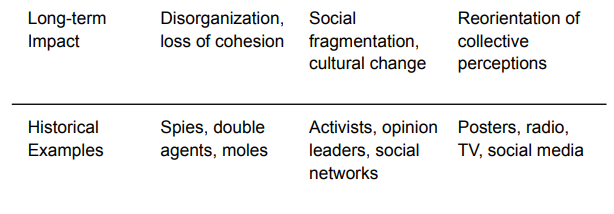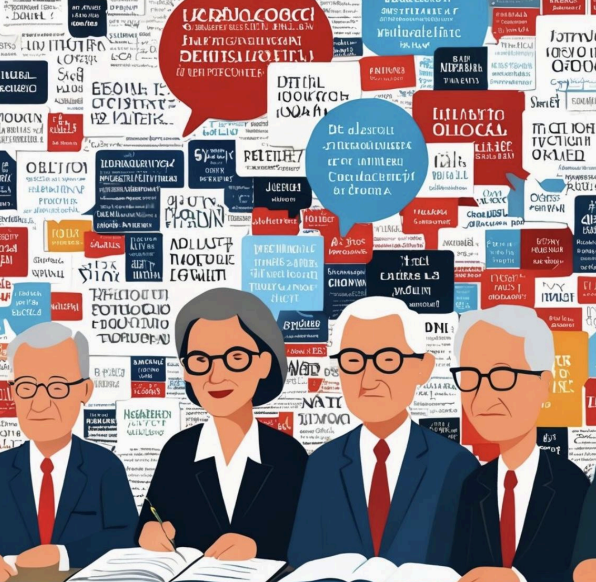Different Styles of Infiltration
Ideological subversion refers to the set of processes aimed at undermining,
transforming, or destroying the foundations of a society, a state, or a social
group by altering its beliefs, values, norms, and structures. This dynamic,
rooted in the long history of political, religious, and social struggles, unfolds
through distinct yet complementary methods: infiltration, social infiltration, and
propaganda. Each of these methods has its own logic, operational modes,
preferred targets, and expected effects. Their systematic coordination forms
the backbone of modern subversive strategies, as theorized and implemented
by totalitarian regimes, revolutionary movements, and powers engaged in
psychological warfare.
I. Infiltration: Clandestine Penetration, Sabotage, and Internal
Demoralization
In the strict sense, infiltration consists of the secret introduction of agents,
activists, or collaborators into an organization, institution, or influential group.
This method, historically associated with espionage, counterinsurgency, and
political warfare, aims to undermine internal cohesion, gather sensitive
information, influence strategic decisions, and prepare acts of sabotage or
destabilization.
Main objectives of infiltration in ideological subversion:
● Intelligence collection and exploitation:infiltrators gain access to
confidential data, networks of influence, action plans, and structural
vulnerabilities, enabling the preparation of targeted operations.
● Manipulation of elites and decision-makers:by integrating into ruling
circles, infiltrators steer debates, influence policies, create divisions, and
encourage decisions contrary to the group’s interests.
● Demoralization and disorganization: through the introduction of rumors,
deviant behaviors, or internal conflicts, infiltration seeks to erode trust,
provoke suspicion, and weaken collective morale.
Infiltration relies on proven techniques: the use of false identities, the patient
building of trust, the exploitation of psychological and institutional
weaknesses, and the use of duplicity and concealment. Infiltrators act over the
long term, in total discretion, favoring indirect and gradual action. Historically,
this method was used by intelligence services, political police, revolutionary
movements, and foreign powers—particularly within political parties, trade
unions, religious circles, and civil society organizations.
II. Social Infiltration: Diffuse Transformation of Norms and
Community Polarization
Social infiltration differs from classical infiltration in its scope, methods, and
objectives. It no longer consists merely of penetrating an organization to
sabotage it from within, but of integrating individuals or groups into social
networks, local communities, and cultural or professional environments in
order to influence collective representations, values, and behaviors at a deep
level.
Objectives of social infiltration:
● Modification of norms and cultural references: social infiltrators
gradually introduce ideas, practices, or discourses that challenge the
identity, moral, or symbolic foundations of the target group.
● Creation of divisions and polarizations: by encouraging the emergence
of antagonistic currents, controversies, or internal rivalries, social
infiltration fragments group cohesion, weakens solidarity, and renders
the community vulnerable to external influence.
● Erosion of collective resilience: through active participation in group
activities, assuming responsibilities, and spreading alternative
narratives, social infiltrators undermine the group’s capacity for
resistance and self-defense.
Social infiltration requires prolonged presence, genuine engagement in
collective life, the building of trust networks, and the exploitation of relational
dynamics. This method is particularly effective in contexts where social bonds
are strong and community belonging is a key factor of stability. It has been
widely used in ideological influence campaigns, cultural warfare strategies,
and mass manipulation operations in the digital era.
III. Propaganda: Mass Manipulation, Control of Perception,
and Mobilization of the Masses
Propaganda represents the most visible, systematic, and massive dimension
of ideological subversion. It consists of the organized dissemination of
messages, images, narratives, or slogans aimed at shaping beliefs, molding
attitudes, and mobilizing the behavior of a population. Whether political,
religious, or commercial, propaganda relies on the exploitation of emotions,
the repetition of themes, the simplification of discourse, and the polarization of
opinions.
Objectives of propaganda in ideological subversion:
● Modification of perceptions and collective representations: through
repetition, propaganda imposes a worldview, legitimizes an ideology,
designates enemies, and glorifies heroes.
● Control of public opinion and mobilization of the masses: propaganda
seeks to influence electoral choices, provoke adherence or revolt,
channel discontent, and transform frustration into collective action.
● Disruption of psychological and institutional defenses: by saturating the
public sphere with contradictory narratives, rumors, and false
information, propaganda weakens individuals’ and groups’ capacity for
discernment, criticism, and resistance.
Modern propaganda uses all available media: print, radio, television, cinema,
posters, social networks, viral campaigns, and more. It exploits techniques of
social psychology, conditioning, suggestion, and emotional manipulation. It
may take the form of agitational propaganda, which seeks to inflame anger,
identify scapegoats, and prepare popular uprisings, or integrative propaganda,
which aims to stabilize a regime, strengthen cohesion, and neutralize
opposition.
IV. Historical and Strategic Integration of Subversive Methods
Historically, infiltration, social infiltration, and propaganda have been used in
combination according to strategic logics adapted to political, social, and
technological contexts. As early as the sixteenth century, with the rise of
printing and the spread of pamphlets, agitational propaganda emerged as a
lever of revolutionary mobilization, preparing the ground for subversive action
and the seizure of power. The French Revolution, the Russian Revolution, the
rise of Nazism, and the totalitarian movements of the twentieth century
illustrated the power of these methods: infiltration of parties and unions,
penetration of elites, manipulation of the masses through propaganda, and the
exploitation of popular discontent and frustration.
In modern warfare, subversion has become an auxiliary weapon—preparing
the ground for military or political action, undermining the legitimacy of
authority, demoralizing defenders of the established order, and neutralizing the
capacity of the masses to mobilize in defense of the state. Totalitarian regimes
perfected these techniques, combining subversion as a preparatory phase,
propaganda as a tool of mobilization, and social infiltration as a vehicle for
transforming norms, values, and behaviors.


VI. Contemporary Implications and Perspectives
In the digital information era, the combination of infiltration, social infiltration,
and propaganda has grown significantly stronger: social networks enable
rapid and massive penetration of communities, algorithmic manipulation
fosters polarization, and information saturation makes it increasingly difficult to
distinguish truth from falsehood. States, influence groups, and non-state
actors now possess sophisticated tools to conduct global subversion
campaigns, exploiting the structural, psychological, and cultural vulnerabilities
of modern societies.
A deep understanding of these methods, their historical interconnection, and
their effects on social and political stability is essential for developing
strategies of resilience, counter-influence, and informational defense suited to
contemporary challenges.
Paul-Michel Manandise



